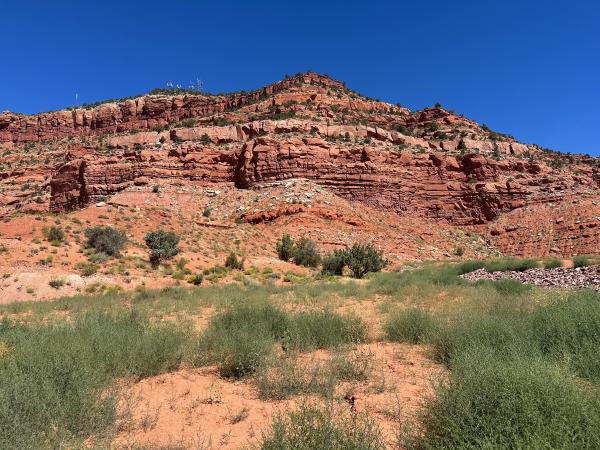Passive House
The term ‘passive house’ may easily give the wrong impression of being 100% passive. A passive house improves and emphasizes the static components and design of a house (walls, windows, insulation, orientation) so that the active components (heating, cooling) can be minimized. This results in significant energy savings as well as improvements in comfort.
My brother Bjørn Kierulf at Createrra has built over 100 passive houses in Slovakia and elsewhere in Europe, so when we started this project, it was natural that we would build this way. I’m not an expert, but have been learning a lot, so I want to give a layman’s overview on how to design and build a passive house.
Water in the Desert
Kanab is at 5000 ft elevation (1524 meters), in a cold semi-arid climate zone, getting only 13.5 inches (343 mm) of precipitation per year. And Kanab has experienced a severe drought. So the landscaping around the house will obviously be xeriscape, no lawn.
Too little water is a serious issue, but so is too much water. Localized rainstorms are common here, and with the rocky landscape, the water will just run off instead of soaking in, leading to flash floods. This is especially dangerous in narrow canyons, as tragically witnessed by recent deaths and dramatic rescues in Buckskin Gulch. Kanab itself also experienced flooding a few years ago.
Rooms and Spaces
As a vacation home, most anything will work when it’s just the two of us. But the house also has to work when we bring friends and family. And it has to work as a vacation rental when we’re not there.
Lots of tradeoffs – we want to keep it as small as we can, but not cramped. Comfortable, flexible, and practical, not luxurious.
Constraints
The architectural committee of the HOA has some restrictions. The most relevant:
Floor Plan
I started drawing possible floor plans as soon as we started looking at lots – I wanted to be sure we could make them work. My architect brother provided feedback, then I went off and drew another idea. A year of looking at different lots gave me some practice. Once we zeroed in on our lot and started working with the PHPP spreadsheet to estimate heat gains, the drawings became more realistic.
Roof and Patios
We knew we wanted a shed roof over the northwest corner to maximize the views in that direction. However, all the existing houses in La Estancia were built with hip roofs, and it wasn’t quite clear how to best combine the two. However, the HOA decided to require mostly flat roofs in the newly developed area, so that worked out well.
Local architect Robert Kaczowka at Mesa Design helped us figure out the roof shape. He also came up with the stretched out roof for the southwest patio, which gave the house a stronger horizontal line and really improved the overall look.
Light on Two Sides
I’ve talked a lot about the view out – let’s talk about the light coming in.
Pattern 159 in Christopher Alexander’s excellent “A Pattern Language” is Light on two sides of every room. To quote:
This pattern, perhaps more than any other single pattern, determines the success or failure of a room. … Rooms lit on two sides, with natural light, create less glare around people and objects; this lets us see things more intricately; and most important, it allows us to read in detail the minute expressions that flash across people’s faces … The light on two sides allows people to understand each other.
Smaller Redesign
Our lot actually has things growing on it. But not a house, yet. Time for an update.

Long story short, it took a long time for our builder to get quotes from subcontractors. When he finally got us an estimate, the cost was significantly higher than we had ever anticipated. At that price, the project was not within our budget, and didn’t make sense.
Back on Track
The project is back on track:
- Plans are final, engineering has been done.
- We have a signed agreement with our builder.
- The builder is excited to work on a project that’s a bit different.
- Cost estimates are still high, but no longer completely out of reach.
- Timeline is still in flux, but building might start in a few weeks!
Floor plan changes
The floor plan was pretty close in September, but even so, it could be optimized quite a bit. Here’s the September version:
Windows
Windows are a balancing act between light, views, insulation, heat gain, and of course cost. Passive house windows need to be triple-pane, their frames need to insulate well, and they need to seal tightly, so they will necessarily cost more than regular windows.
Detailed quotes
We got quotes from multiple vendors, and made a lot of changes in response to those quotes, optimizing number, size, and type of windows. To do that, we needed detailed quotes listing the cost for each window, instead of just giving us one (very large) number. Without that, you’re limited in knowing what you can do to keep costs down.
Placement on the Lot
The original plans put the house at the minimum setback from the front (25 ft). We needed to do that because the house was bigger and we had limited space in the northwest corner of the lot.
With the smaller design, we gained a lot more flexibility on where to place the house. We decided to move it 5 ft back from the setback line (30 ft instead of the minimum 25 ft). The backyard is still more than big enough, and this makes the driveway a bit longer, and thus less steep.